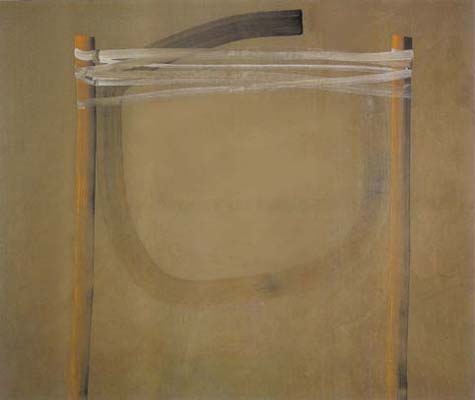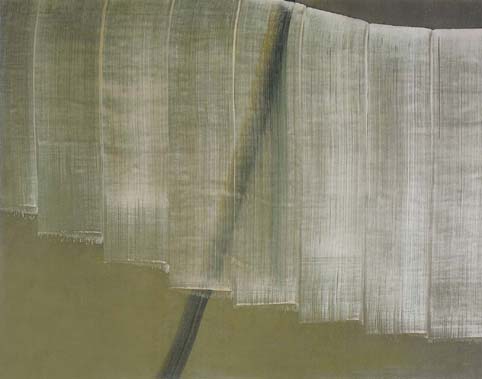宋賢淑展
What Place? Roman Kurzmeyer Painters touch every part of the canvas. In this technical sense, there is an exclusive relationship between author and work in painting that exists in no other art form, and paintings from the modern era to the present communicate that relationship to the viewer. "With photography," wrote Walter Benjamin in 1935, "the hand was relieved of the most important artistic responsibilities in the process of pictorial reproduction for the first time. These responsibilities were now assumed solely by the eye gazing through the lens." It was not until the age of technical reproduction that the craft of painting evolved from a learnable, teachable skill to a specific technique oriented toward a conceptual accomplishment. In his seminal essay, Benjamin describes how the concept of the work of art, and thus also the social status of the artist, began to change in the course of the restructuring process that affected society as a whole throughout the 19th century. He recognized that the properties of photography and film as media were particularly well suited to the accelerated development of mass visual culture in his time. Thus photography, and especially film, are not described only as artistic media but also as means of reproducing images. Today, there are many images that can be accessed simultaneously everywhere. The weakening and dissolution of local cultures, including those of Europe, is at least in part the result of this decontextualization of visual images. Under these circumstances, there can be no more visual history as a traditional context that effectively spans all generations and thus fosters continuity in the self-conception and self-interpretation of culture. Thus it is no coincidence that the study of style characteristic of Walter Benjamin's time, with its concern with the forms, materials and the history of art, has now largely given way to a focus on the contents of art and its communicability. One consequence of this shift of perspective in the 20th century is that questions about the aesthetics of production have become secondary to questions regarding the aesthetics of reception in art and art theory. The history of art is now perceived through different eyes. Today, emphasis is placed on the instrumental properties of a work of art. Contemporary painting is expected to develop from a relationship to the viewer. There are film sequences showing Hyun-Sook Song painting. The artist shows in these recent shots filmed in her studio how the viewer is expected to perceive the process of painting. At the end of the sequence, Hyun-Sook Song's wipes the painted image from the canvas. It is possible to demonstrate how a picture is painted in front of a camera, but not to create a painting. As she paints, Song stands barefoot on a rough plank laid over two beams. She moves sure-footedly along this narrow plank bridge above a primed canvas painted with a monochrome background and spread out on the floor, bends down and applies a brushstroke to the canvas. The painting process is interrupted after each brushstroke. If the work comprises only a single brushstroke, the painting is finished once this brushstroke, applied with intense concentration, is completed. Otherwise, the artist stops and comes down from the bridge, either to replace the brush with a different one or to soak it with paint again in preparation for the next brushstroke. The canvas surface is the only color field in her paintings, as the figures are always composed of a few, distinct strokes. Hyun-Sook Song counts the brushstrokes and entitles each of her paintings with the number of strokes needed to complete it. Every line reveals the process of its own production. The artist dips a small brush into the mixed egg tempera, applies one or several lines of different colors to the large paintbrush, climbs back onto the plank bridge, touches the brush to the canvas and draws a stroke. The stroke may consist of one or two colors. The colors intermingle during the painting process. Each line is created in a continuous motion, the course of which is legible in the painting. One of the artist's self-imposed rules is that she must never start the same brushstroke twice. If there is not enough paint on the brush to complete the line, she wipes the paint away and starts over again. Each painting is created in a single, coherent step. The brushstrokes are applied to wet canvas. It is not only in a technical sense that Hyun-Sook Song treats her paintings as places. She paints simple pictorial signs for places, such as bridges, pots, houses, tracks, etc. on the monochrome backgrounds of her works. In a dual sense, these topological motifs are signifiers without objects of reference. The pictorial signs allude to a second level of reality, a geographic and cultural context beyond the sphere of painting, namely "Asian culture." The simultaneous intonation of the pictorial signs on the monochrome background makes it clear that these are references without content, however. This world exists only as painting, and it is recalled as such by the artist. Hyun-Sook Song was born the daughter of a rice farmer and grew up in a small Korean mountain village. Her mind is full of images of her Korean homeland and culture, in which she lived into her adult years and to which she feels a sense of belonging even now, after more than twenty years of life in Germany. Yet it is not this rural world of her childhood in South Korea that Hyun-Sook Song depicts in her painting. What appears on the canvas in the mode of the motion of the brush is her reflection on these origins. Those who know nothing about the world of her childhood will not find it in her painting. She describes neither the everyday life of a Korean peasant family in the 1960s nor traditional Korean rituals and customs. All of that is found only in her films, which are produced in close collaboration with her German companion Jochen Hiltmann. In her films, we see Hyun-Sook Song, dressed in traditional clothing, driving a post into the ground with vigorous hammer blows; we see her aging parents producing silk again for the benefit of the camera on their farm or the performance of a Shaman called upon by the family. Her painting serves no ethnographic purpose. It is not a lost place that Hyun-Sook Song depicts in her paintings but rather a concrete place created through the painting itself, a place the viewer can also experience. Our society, which art historian Hans Belting refers to as the "global technical civilization," places a premium on visual representation, the process of forming and shaping the world. The artist's field of activity is broad and encompasses to an increasing extent not only product design, architecture, fashion and visual communication but also the concept of reality itself. Art is also involved in the visual shaping and mediatized communication of reality, as a means of demonstrating its own role in society. Creativity, a key concept of post-war modernism since the German sculptor Joseph Beuys expanded the concept of art with such effective public impact, can be allied with social and political responsibility, for example. Hyun-Sook Song takes a different view of the role of the artist and the function of the work of art. Her art does not refer to contexts of social action but evokes the sense of a void transformed into meaning. She works consciously and constructively at the zero point of art, to which she returns in each new work. "All of the great narratives," wrote Hyun-Sook Song in 1994, "in which the people of the world anchor their lives, were taken from me long ago. Homeland, mother tongue, religion and custom have long since parted from my everyday life, raised from the living to art. I have been thrown back upon my self. This self is what is condemned to silence in us all, and yet is understood, across all cultural boundaries." This personal experience of deterritorialization, decontextualization and the silencing of her own existence is a genuinely modern phenomenon and well documented in comparable statements in the writings of many artists. The setting of the post identifies a place. Hyun-Sook Song's brush marks are not brushstrokes in the strictest sense of the word but brush tracks, since the act of setting the brush on the canvas, the direction in which paint is applied and finally the completion of the stroke and the lifting of the brush from the canvas are all readily traceable in the painting. Although this seemingly gestural and spontaneous painting style is emphatically physical (contingent), it is nevertheless precisely calculated (conceptual) as well. With her paintbrush, Hyun-Sook Song establishes boundaries of place and time which the individual viewer perceives in his own way. Her painting is not suitable for mass visual consumption. Which leads us back to Walter Benjamin and his characterization of "aura" whose "shattering" he identifies as the beginning of the age of mass culture: "What is aura, really? A strange web of space and time: a unique manifestation of distance, however near it may be. If, while resting on a summer afternoon, you follow with your eyes a mountain range on the horizon or a branch which casts its shadow over you, until the moment or the hour becomes part of its manifestation, you experience the aura of those mountains, of that branch." Hyun-Sook Song has developed a method of suspending her own heterotopic identity in the painting through processes of maximum mental and minimal technical shifts in such a way that the viewer also experiences presence in place and time.











